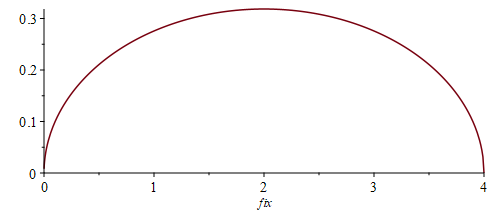Consider the symmetric group . Let
count the number of fixed points of a permutation
. Where
, we have that for a random permutation
chosen with respect to the uniform distribution, the
converges in distribution to
in the sense that:
.
In this note we will look at the distribution in the case where the uniform distribution is conditioned on .
Theorem
Let be chosen according to the distribution uniform on permutations for which one is a fixed point. The number of fixed points has distribution
in the sense that, where
,
.
Proof: What can be shown, ostensibly from stuff from the quantum permutation side of the house is that, where is integration against the uniform distribution, and
is integration against the uniform distribution on permutations with one a fixed point, that, for
:
,
the -st Bell number. Now consider the moments of
:
,
using the fact that the Bell numbers are the moments of that Poisson distribution and the standard recurrence for the Bell numbers.
Local vs Global Conditioning of Quantum Permutations
In the quantum case we define
,
where is the fundamental magic representation. The moments of
with respect to the Haar state are the Catalan numbers and it follows that the law of
is a Marchenko-Pastur distribution, with density
:

Note that when we measure the Haar state with some finite spectrum version of we find:
- the probability of finding an integer number of fixed points is zero, and
- independently of
, the probability of finding more than four fixed points is zero.
In the classical case above when we chose the permutation uniformly from those who fix one, there are two ways of viewing it:
- we pick an element of
that fixes one, OR
- we consider the isotropy subgroup
and choose our permutation from
.
Classically, these are the same thing. In the quantum case these two things can be interpreted differently. The second case is quite clear in the quantum case. For , we take the isotropy
via the quotient
.
The analogue of the uniform distribution on here is the Haar idempotent
. Note this maps
to
. Now, using the fact that
, the Catalan number, we have that the moments of
with respect to
is the binomial transform of the Catalan numbers (the binomial transform of
is
). It follows, using similar stuff to the above, that the distribution of
with respect to
is just a shifted version of Marchenko–Pastur:

I guess this is marginally more interesting than the unshifted version.
Now, what about an analogue of “we pick an element of that fixes one”. So if we take the Haar state and measure the observable
that asks of a quantum permutation, does it fix one, we get, conditioned on this, the state:
.
And, it turns out, as above, using stuff from the quantum permutation side of the house:
.
Quite quickly from here we find that the density of the distribution of with respect to
is

This is so interesting:
- it doesn’t change the support — we still find between 0 and 4 fixed points,
- we have a new symmetry about
, we had another unexpected symmetry here.
- the mean jumps from one to two, that is not unexpected, but
- the mode jumps from zero to two!
- even though we have observed one to one, there can still be less than one fixed point when we measure… and this happens with probability
.
The next obvious question is what happens with:
Epilogue?
So what about this local vs global conditioning? Well, no matter what subsequent measurements are made to , we will always find that one is a fixed point. That conditioning is ‘global’.
This is not the case with , and why the support of the law is not bounded above one, like that of the globally conditioned
. In fact, there is a non-zero probability that
is observed to fix two but then subsequently not fix one anymore. That conditioning was only local: the probability that
fixes one is 100%… but subsequent measurements can destroy that conditioning… it is only local.

Leave a comment
Comments feed for this article